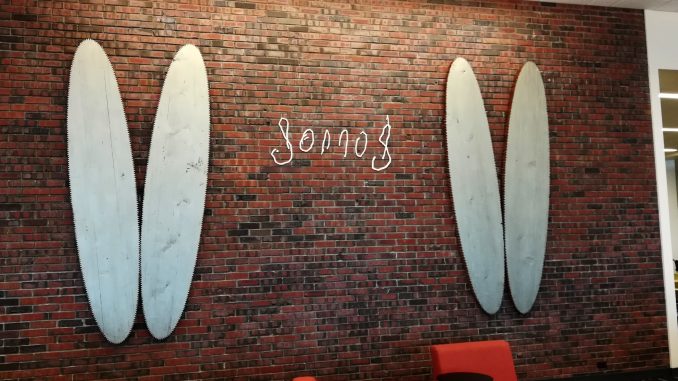
Months after its reinstallation, Terry Adkins’ Mvet Truth was formally celebrated at the Sojourner Truth Library. Several members of the art department and the library gathered there to honor the piece and Adkins’ life.
The event took place right in front of Mvet Truth during normal library hours, as students looked on as the celebration unfolded. The celebration was presented by Mark Colvson, the Dean of the Library.
“I’d like to welcome everyone here today, the faculty of the school of fine and performing arts, library faculty, faculty and staff of the campus and students,” Colvson said. “We are very grateful to have you here today to celebrate the reinstallation of Terry Adkins’ Mvet Truth here in the library.”
Adkins is known for his work as a visual artist. He was trained by fellow visual artists Aaron Douglas and Martin Puryear and earned a B.S. in printmaking at Fisk University, then receiving an M.S. at Illinois State University before finally achieving an M.F.A. in sculpting at the University of Kentucky.
From there, he led a long and illustrious art career, blending a wide variety of disciplines, using sculpture, video, performance and photography. His sculpting is known for its striking visual style.
Adkins was also an educator. He was a professor at SUNY New Paltz between 1993 and 2000 before he taught at the University of Pennsylvania. He continued to teach there until his untimely death in 2014. He was 60 years old.
The piece was donated to the library by Adkins in the spring of 1996 and installed in the main entrance of the lobby. The piece itself was dedicated to the library’s namesake, Sojourner Truth. On the piece, Adkins has said “MVET is onomatopoetic, it refers to the sound made by some West African instruments. It is also symbolic of [Sojourner Truth’s] love of music and her angelic nature.” Art Professor Kathy Goodell stated that Adkins had a deep connection to Truth and a “real allegiance to history.” This was a factor in his decision to donate the piece to the library.
When the library was being renovated back in 2014, the piece was put away in storage for the duration of the construction. However, even after the renovations, the piece did not go up for months.
“[We] had a big challenge in figuring out in how to get it back in the right place.” said Colvson, Dean. He had contacted Adkins widow, Merele Williams-Adkins, and the other faculty members for their opinion on the matter.
The library eventually came to the conclusion that the piece should be placed on the massive wall near the library’s stairwell. The piece itself consists of two pairs of large, ovular cog-like structures with Sojourner Truth’s signature between them. Goodell had a hand in the reinstallation of the piece by restoring Truth’s signature.
After Colvson’s remarks, members of the art department spoke about Adkins’ life and the piece. Guest speakers include Professors Goodell, Reva Wolf, Francois Deschamps, and Robin Arnold. Dorksy Curator Anastasia James was set to speak that night but unfortunately was not able to.
The speakers all fondly remembered their friend and commented on the importance of this piece.
“Any of you who knew Terry, knew that he loved to talk and loved to debate and argue.” Wolf said. “He was very engaging to speak to and one would always learn so much having a conversation with him.”
Wolf and Adkins would frequently talk about the Harlem Renaissance artist Aaron Douglas. Wolf felt that Douglas’ art resonated with Adkins’ due to how they connected visual art and music. She presented Douglas’ piece Aspects of Negro Life to the audience, explaining how both of these artists and their work connect to one another.
Goodell also shared her thoughts on Adkins and Mvet Truth. She read from a eulogy she wrote in “Title,” an art magazine based in Philadelphia. Other students had also submitted eulogies about Adkins to this magazine after his death.
“Terry seized the moment!” Goodell said. “He was larger than life! He was a subversive classicist, a scholar and impudent observer; he was whatever he wanted to be in the moment.”
She talked about Adkins’ love for music, the strength of his work and his understanding “that opposites are connected with one another, they create and transform.”
Dechamps also spoke, expressing his love for the piece and his fascination of the cog like structures that Adkins created. He also praised the new location of the piece, and how Adkins inspired him to be more personal when it came to his art. Arnold did not speak, but Colvson read a touching eulogy written by her. Colvson wrapped up with a few closing remarks, and the celebration was finished.
After this celebration, Colvson expressed his hope will be more interested in the piece and Adkins himself. “I just hope that it will inspire more people to be inspired by Adkins work,” Colvin said.
